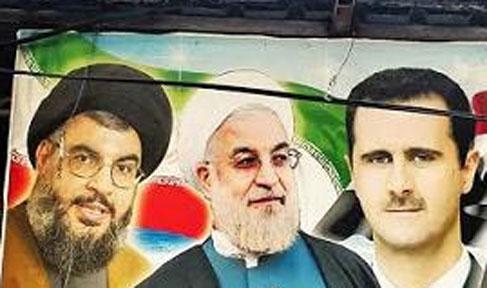Stronger Iran, mightier Assad? How Tehran’s ‘billions’ go to Damascus
Dr. Majid Rafizadeh/Al Arabiya/Friday, 24 July 2015
In the ongoing 4-year-long civil war, the Islamic Republic- one of the major bank-rollers for the Syrian government- has reportedly spent between $6 and $35 billion a year in order to keep its staunchest regional ally, Bashar al-Assad in power. This amount of spending is significant considering Iran’s military budget is roughly $15 billion a year. Iran’s economic assistance to the Syrian government comes in different avenues including oil subsidies (approximately 60,000 barrels of oil per day), credit lines, and military assistance. What is more intriguing though, is that even before the nuclear deal was reached (when Tehran faced severe economic sanctions and was cut off from the global financial system), Iranian leaders did not halt their support of Assad financially, militarily, or through intelligence and advisory means. But, how is the recent Iranian nuclear deal going to affect Assad’s fate? Will the Iranian-U.S. rapprochement and the closer tactical and strategic cooperation pave the way for the stepping down of Assad or instead empower his rule? Will the recent tactical and strategic shift in American policies evident in the U.S. invitation to Iran to be part of the solution damage Assad’s interests? Why are the Iranian leaders so determined to lose billions of dollars to keep Assad in power? Will the nuclear deal change the Islamic Republic’s support for the Syrian government?
Iran’s financial support
To reach answers for the above questions, a few statements need to be made. Firstly, five major groups play a crucial role in maintaining Assad’s rule:
1. The Syrian armed forces: namely, the Syrian Arab Air Forces, Military
Intelligence (Mukhabarat), and the Syrian Army (al-Jaysh al-Arabi as-Suri)
2. Syrian Shiite proxies (which operate under the banner of the National Defense Force).
3. Foreign Shiite Proxies (namely from countries such as Iraq and Afghanistan,)
4. Hezbollah, and
5. Quds Force (an elite branch of Iran’s Revolutionary Guard Corps operating in foreign territories)
All of these five categories are financially (directly or indirectly) assisted by the Iranian ruling establishment. Nevertheless, even before the nuclear deal was reached, there were some concerns among Iranian leaders who questioned the cost and benefit of hemorrhaging billions of dollars on Assad. Assad was likely also concerned about the possibility of financial cuts or a change in Iran’s political calculation in supporting him. Nevertheless, the nuclear deal, the gradual lifting of sanctions, and the release of about $100 billion in frozen assets has definitely eased Iran’s financial concerns and removed Assad’s fears.
Crucial lifting of arms embargo
Bashar al-Assad congratulated Iran’s Supreme Leader, Ayatollah Ali Khamenei, for the nuclear deal calling it a “major turning point”. But will it also be a major turning point for Assad?
The nuclear deal partially eliminated Assad’s concerns that Iran might have to cut down financial support to his government
The Syrian opposition and rebel groups clearly showed their dissatisfaction with the signing of the nuclear deal between Iran and the West.
Financially speaking, the nuclear deal partially eliminated Assad’s concerns that Iran might have to cut down financial support to his government.
But what is more crucial for Iran-Syria relations is indeed the lifting of the arms embargo, which Iranian leaders fought for so vehemently in the last few days of the nuclear deal. The arms embargo will be lifted gradually in the coming years. China and Russia are likely already beginning to chart ways to make billions of dollars by selling advanced weaponry to Iran. This can open a channel for Assad’s army to be equipped by the Islamic Republic with more sophisticated arms.
In other words, the Iranian-West rapprochement and the closer tactical or strategic cooperation can be a blessing for Assad more militarily rather than financially.
Nevertheless, it is crucial to point out that although the Islamic Republic will be less restrained to send the Syrian government financial support (such as the recent $1 billion credit line from Iran to Syria) and advanced weaponry, this phenomenon is not likely to dramatically change the course of the conflict in favor of Assad.
Obama’s post-deal hopes
After the nuclear deal, President Obama is going to focus on cooperating with Iran strategically (not only tactically) on several crucial issues in the region. Recently, President Obama signaled a policy shift in the White House’s position towards Iran’s role in Syria. While the U.S. forcefully opposed the Islamic Republic’s participation in previous peace talks on Syria (including objecting to the U.N. invitation to Iran to attend the 2014 peace conference on Syria), he pointed out that Iran should now be a part of the efforts to resolve the conflict in Syria. “I think it’s important for them to be part of the conversation,” the president stated. The conflict has led to one of the worst humanitarian tragedies of our generation. The president however added, “We have not, and I don’t anticipate any time in the near future, restored normal diplomatic relations with Iran”. But from the perspective of the White House, the nuclear deal seems to open avenues for strategic cooperation between Washington and Tehran, since there is currently a direct line of communication between American and Iranian leaders. Privately, Iranian leaders will likely accept America’s invitation to participate in talks regarding Syria for several reasons.
1. From the Iranian leaders’ perspective, the U.S.’s invitation further projects Iran’s power in the region.
2. Iranian leaders might be capable of altering the U.S. position towards Assad: leave him in power.
3. If the U.S. insists on Assad stepping down, America can be persuaded to follow a policy which allows the ruling Alawites to stay in power. Iran is not married to Assad per se, but to the ruling Alawite establishment and Syrian state
4. For Iranian leaders, America’s invitation to Iran projects limited American power in the globe and its failed exceptionalism.
Complexities and nuances of Iran’s role in Syria
The tactical shift in America’s stance towards the Islamic Republic is intriguing. On the one hand, any policy that can alleviate the excruciating pain the Syrian people and refugees are facing should be welcomed. Yet, there exists several shortcomings in the U.S. tactical or strategic shift. First of all, we need to analyze Iran’s regional priorities. From Khamenei’s and the IRGC’s perspective, Iran’s defense system and its security are top priorities. When it comes to Iran’s security, it is inextricably linked to Iran’s decades of investments in Lebanon, Iraq, Syria as well as the proxies that Tehran has given birth to or financed across the region.
The Syrian civil war has provided another platform for Iran in establishing more sophisticated networks of Shiite proxies not only in Syria but beyond. Currently, maintaining the Alawites in power is a significant matter of national security for Iranian leaders. Syria can be viewed as a lynchpin of several crucial relationships and networks of Shiite proxies across the region for Iran.
The Islamic Republic is not committed to Assad as a leader, but rather Iran backs the ruling Alawite establishment. In order to save the billions of dollars that it is sending to the Syrian government, Tehran might agree to part with Assad, but definitely not with the Syrian state.
From the Iranian leaders’ perspective, leaving the Syrian state altogether will result in the rise of a Sunni majority to power, which will significantly tip the regional balance of power against Tehran and endanger its security, geopolitical interests and regional hegemonic ambitions. It can negatively affect Iran’s network of Shiite proxies as well. In addition, forcing Assad to step down but maintaining the Alawite ruling establishment in power is not going to satisfy the demands of hundreds of armed rebel groups. Third, the Islamic Republic is partially bogged down in Syria by the same approach the U.S. faced in Iraq and Afghanistan. But what highlights the complexity of Iran’s role in Syria is that its incentives are not only geopolitical, but sectarian (Shiite vs Sunni), ethnic (Persian vs Arab) and ideological (Pro-U.S. and Pro-Arab states vs Anti-U.S. and Anti-Arab states). Obama’s offer seems to be too late though.
The conflict and civil war has spiraled out of control. The Islamic Republic played a crucial role in fueling the conflict in Syria by assisting Assad’s crackdown, leading to the rise of endless domestic and global rebel and extremists groups operating in Syria. Even if we idealistically believe that Iran is going to change its position towards Assad, there still exists the challenge of how to subdue the powerful oppositional armed and extremist groups such as the Islamic State (which have paralyzed the international community’s efforts in defeating them). Iranian leaders are viewing themselves as being on the winning side. Therefore, what are their incentives to change their political calculation? Iran observes that even Western politicians, diplomats, policy analysts, and scholars have come to agree with the notion that Assad is a better option than the alternatives. The West is buttressing and repeating Khamenei’s and Assad’s lines. Finally, Iran might agree to leave the individual Bashar al Assad but not the Alawite state. Syria is a matter of grave national security for Iran and Damascus is a linchpin for maintaining Tehran’s sophisticated network of Shiite proxies across the region.




















